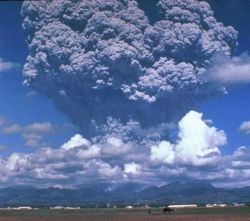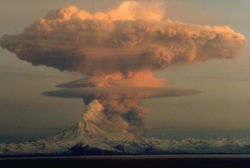Eruption column
2008/9 Schools Wikipedia Selection. Related subjects: Geology and geophysics
An eruption column consists of hot volcanic ash emitted during an explosive volcanic eruption. The ash forms a column rising many kilometres into the air above the peak of the volcano. In the most explosive eruptions, the eruption column may rise over 40 km, penetrating the stratosphere. Stratospheric injection of aerosols by volcanoes is a major cause of short-term climate change.
A common occurrence in explosive eruptions is for column collapse to occur. In this case, the eruption column is too dense to be lifted high into the air by air convection, and instead falls down the flanks of the volcano to form a pyroclastic flow or surge.
Formation
Eruption columns form in explosive volcanic activity, when the high concentration of volatile materials in the rising magma caused it to be disrupted into fine volcanic ash and coarser tephra. The ash and tephra are ejected at speeds of several hundred metres per second, and can rise rapidly to heights of several kilometres, lifted by enormous convection currents.
Eruption columns may be transient, if formed by a discrete explosion, or sustained, if produced by a continuous eruption or closely spaced discrete explosions.
Structure
The solid or liquid material in an eruption column is lifted by processes which vary as the material ascends:
- At the base of the plume, material is forced upwards out of the vent by the pressure of expanding gas, mainly steam. The gas expands because the pressure of rock above it rapidly reduces as it approaches the surface. This region is called the gas thrust region and typically reaches to only one or two kilometres above the vent.
- The convective thrust region covers most of the height of the plume. The gas thrust region is very turbulent and surrounding air becomes mixed into it and heated. The air expands, reducing its density and rising. The rising air carries the solid and liquid material from the eruption entrained in it upwards.
- As the plume rises into less dense surrounding air, it will eventually reach an altitude where the hot, rising air is of the same density as the surrounding cooler air. In this neutral buoyancy region, the erupted material will then no longer rise through convection, but solely through any upward momentum which it has. This is called the umbrella region, and is usually marked by the column spreading out sideways. The eruptive material and the surrounding cool air has the same density at the base of the umbrella region, and the top is marked by the maximum height which momentum carries the material erupted. Because the speeds are very low, or negligible in this region it is often distorted by stratospheric winds.
Column heights
The column will stop rising once it reaches an altitude where it is no longer less dense than the surrounding air. Several factors control the height that an eruption column can reach.
Intrinsic factors include the diameter of the erupting vent, the gas content of the magma, and the velocity at which it is ejected. Extrinsic factors can be important, with winds sometimes limiting the height of the column, and the local thermal temperature gradient also playing a role. The atmospheric temperature in the troposphere normally decreases by about 10 K/km, but small changes in this gradient can have a large effect on the final column height. Theoretically, the maximum achievable column height is thought to be about 55 km. In practice, column heights ranging from about 2-45 km are seen......
Eruption columns over 10-15 km high break through the tropopause and inject ash and aerosols into the stratosphere. Ash and aerosols in the troposphere are quickly removed by rain and other precipitation, but material injected into the stratosphere is much more slowly dispersed, in the absence of weather systems. Substantial amounts of stratospheric injection can have global effects: after Mount Pinatubo erupted in 1991, global temperatures dropped by about 0.5°C. The largest eruptions are thought to cause drops of up to several degrees, and are potentially the cause of some of the known mass extinctions.
Eruption column heights are a useful way of measuring eruption intensity since for a given atmospheric temperature, the column height is proportional to the fourth power of the mass eruption rate. Consequently, given similar conditions, to double the column height requires an eruption ejecting 16 times as much material per second. The column height of eruptions which have not been observed can be estimated by mapping the maximum distance that pyroclasts of different sizes are carried from the vent – the higher the column the further ejected material of a particular mass (and therefore size) can be carried.
Hazards
Column collapse
Eruption columns may become so laden with dense material that they are too heavy to be supported by convection currents. This can suddenly happen if, for example, the rate at which magma is erupted increases to a point where insufficient air is entrained to support it, or if the magma density suddenly increases as denser magma from lower down in a stratified magma chamber is tapped.
If it does happen, then material reaching the bottom of the convective thrust region can no longer be adequately supported by convection and will fall under gravity, forming a pyroclastic flow or surge which can travel down the flanks of a volcano at speeds of over 100 km/hour. Column collapse is one of the most common and dangerous volcanic hazards in a plinian eruption.
Aircraft
Several eruptions have seriously endangered aircraft which have encountered the eruption column. In two separate incidents in 1982, an airliner flew into the upper reaches of an eruption column generated by Mount Galunggung, and the ash severely damaged both aircraft. Particular hazards were the ingestion of ash stopping the engines, the sandblasting of the cockpit windows rendering them largely opaque and the contamination of fuel through the ingestion of ash through pressurisation ducts. The damage to engines is a particular problem since temperatures inside a gas turbine are sufficiently high that volcanic ash is melted in the combustion chamber, and forms a glass coating on components further downstream of it, for example on turbine blades.
In one case, the aircraft lost power on all four engines, and in the other, three of the four engines failed. In both cases, engines were successfully restarted but the aircraft were forced make emergency landings in Jakarta. See British Airways Flight 9
Similar damage to aircraft occurred due to an eruption column over Redoubt volcano in Alaska in 1989. Following the eruption of Mount Pinatubo in 1991, aircraft were diverted to avoid the eruption column, but nonetheless, ash dispersing over a wide area caused damage to 16 aircraft, some as far as 1000 km from the volcano.
Eruption plumes are not usually visible on weather radar and may be obscured by cloud or night. Because of the risks posed to aviation by eruption plumes, there is a network of nine ash advisory centers around the World which continuously monitor for eruption plumes using data from satellites, ground reports, pilot reports and meteorological models.

